Shop Anki Pronunciation Flashcards
At Speakada, we offer a range of pre-made Anki pronunciation flashcards to help you learn pronunciation effectively. We’ve broken down our done-for-you Anki flashcards into 3 categories: alphabet, IPA and minimal pairs. The pronunciation Anki flashcards are only available in the pronunciation bundle. To purchase select your target language below:
Pronunciation Flashcards: How to Pronounce Words Properly
At the heart of any language are the sounds used for communication, better known as pronunciation. Perfect pronunciation is not just about sounding native. It’s the key to making your words resonate, to being understood with clarity, and to embracing the richness of a new language. But how to pronounce words properly? Pronunciation flashcards hold the key to unlocking this linguistic world.
Imagine having the ability to hear and articulate the distinct sounds of a language with confidence. Picture yourself effortlessly mimicking native speakers, bridging the gap between your words and their understanding.
In this article, we take a closer look at pronunciation flashcards. We’ll explore how these language tools work, their benefits in refining your communication skills, and how to use them effectively to achieve proper pronunciation.
Whether you’re a language enthusiast, a seasoned learner, or someone just beginning their linguistic adventure, this guide will equip you with the knowledge and tools to pronounce words properly and confidently.
TABLE OF CONTENTS
- The Importance of Pronunciation in Language Learning
- Report Findings: The Critical Significance of Pronunciation
- 8 Benefits of Improving Your Pronunciation in a Foreign Language
- What are Pronunciation Flashcards?
- 6 Reasons Why Pronunciation Flashcards Improve Your Language Skills
- 3 Types of Pronunciation Flashcards
- How Do Pronunciation Flashcards Work?
- Research Backing Anki’s Effectiveness in Language Learning
- 3 Steps of Spaced Repetition with Anki Pronunciation Flashcards
- 3 Steps of Active Recall with Anki Pronunciation Flashcards
- Final Thoughts: Pronunciation Flashcards as a Practical Way to Improve Pronunciation in Another Language
The Importance of Pronunciation in Language Learning
The importance of pronunciation in language learning cannot be overstated. It is a foundational element that significantly impacts the overall success of language acquisition.
Pronunciation goes beyond merely speaking words correctly. it plays a pivotal role in effective communication and comprehension.
Report Findings: The Critical Significance of Pronunciation
Professor Fraser from the University of New England (Australia) concluded in a research report that pronunciation was the “most important oral communication skill.”

“Pronunciation is the most important oral communication skill.“
– Fraser, H. (2000). Coordinating Improvements in Pronunciation Teaching for Adult Learners of English as a Second Language.
University of New England, Armidale, NSW.
Speaking another language involves various sub-skills, such as vocabulary, grammar, and pragmatics. Among these, pronunciation stands out as the most crucial. Good pronunciation ensures understanding even if there are other errors, while poor pronunciation can make a speaker challenging to comprehend, regardless of accuracy elsewhere.
Pronunciation significantly influences how others perceive a speaker and affects formal assessments in other language skills. For instance, Professor Fraser points to an Adult Literacy National Project report where a manager underestimated workers’ literacy levels because of their inadequate pronunciation.
8 Benefits of Improving Your Pronunciation in a Foreign Language
Here’s a closer look at the significance of pronunciation in language learning:
1. Clear Communication

Accurate pronunciation is essential for clear and effective communication. Regardless of how extensive your vocabulary or grammatical knowledge is, if you cannot pronounce words correctly, your message may be lost or misunderstood. The ability to articulate words accurately ensures that your intended meaning is conveyed.
2. Listening Comprehension

Pronunciation is not a one-way street. It’s also intrinsically tied to listening skills. When you master correct pronunciation, you become better at understanding spoken language. Native speakers will be easier to comprehend, and you’ll be able to distinguish between words that may sound similar but have different meanings.
3. Cultural Sensitivity

Correct pronunciation reflects respect for the culture associated with the language you’re learning. Mispronouncing words, especially those with cultural or emotional significance, can be perceived as disrespectful or offensive. Learning to pronounce words accurately shows cultural sensitivity and appreciation.
4. Confidence Boost

When you can speak a language with confidence and clarity, it enhances your overall self-assurance in using that language. It encourages you to engage in conversations, ask questions, and participate in various language-related activities without the fear of embarrassment.
5. Professional and Academic Opportunities

In many cases, language proficiency, including pronunciation, is a valuable skill in the professional and academic world. It can open doors to job opportunities, international collaborations, and academic achievements. Accurate pronunciation is often a requirement for language proficiency exams and language-related professions.
6. Credibility

Good pronunciation lends credibility to your language skills. Native speakers are more likely to take you seriously and engage with you when they see that you’ve put in the effort to pronounce words correctly. It also allows you to integrate more effectively into communities where the language is spoken.
7. Reduction of Miscommunication

Correct pronunciation minimizes the risk of misunderstandings. Mispronouncing words can lead to unintended humorous or awkward situations, and in some cases, it can even lead to serious miscommunications. Scott Thornbury, academic and author of the book “An A-Z of ELT”, wrote that “faulty pronunciation is one of the most common causes of misunderstanding.”
8. Enhanced Learning

When you pay attention to pronunciation, you are actively engaged in the language learning process. It encourages you to focus on the sounds, stress patterns, and intonation of the language, which can lead to a deeper and more holistic understanding of the language.
What are Pronunciation Flashcards?
Pronunciation flashcards are a dynamic and interactive learning resource designed to improve language learners’ pronunciation skills. These flashcards typically contain:
- The target word or phrase they want to pronounce correctly.
- An audio component that plays the correct pronunciation.
Pronunciation flashcards may also contain:
- A phonetic aid, like the International Phonetic Alphabet (IPA) symbol, to represent the target sound.
- An example word that includes the target sound.
- A visual aid, like a picture of the example word that includes the target sound.
- Any additional notes or context to provide a clear understanding of the pronunciation challenge.
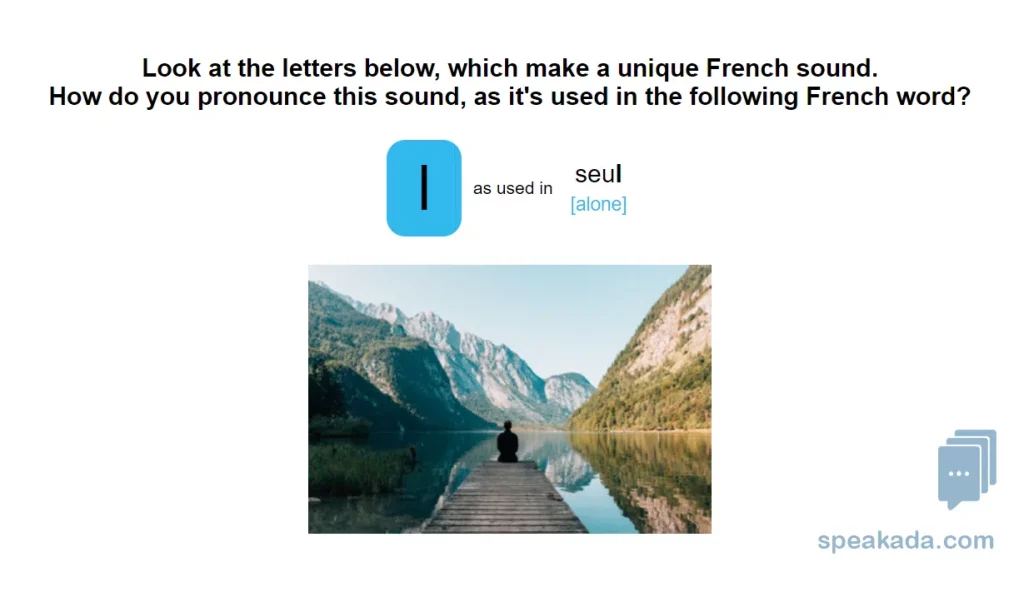
6 Reasons Why Pronunciation Flashcards Improve Your Language Skills
Language proficiency encompasses various components, and one of the fundamental pillars of effective communication is pronunciation. Accurate pronunciation not only ensures that you are understood but also enhances your overall language skills.
Pronunciation flashcards play a crucial role in helping learners refine their pronunciation and, in turn, improve their language skills. Here’s a closer look at the vital role these flashcards play in language development:
- Precision: Pronunciation flashcards provide you with precise guides on how to pronounce words correctly. Each flashcard typically includes phonetic transcriptions, audio clips, and visual aids, ensuring you get a clear understanding of the correct pronunciation.
- Practice Makes Perfect: Pronunciation flashcards allow for repeated, targeted practice. By going through flashcards regularly, you train your tongue and vocal cords to articulate words accurately, making pronunciation second nature.
- Challenging Words: Flashcards can focus on challenging or commonly mispronounced words, helping you conquer those linguistic hurdles. Whether it’s tricky sounds or unique phonetic combinations, flashcards offer the opportunity to master them.
- Vocabulary Enhancement: Learning correct pronunciation is intrinsically tied to expanding your vocabulary. By correctly pronouncing words, you can understand and be understood when encountering new vocabulary. Pronunciation flashcards aid in broadening your vocabulary and ensuring you pronounce words accurately.
- Reduced Anxiety: Flashcards allow you to study your pronunciation in private and when you feel most comfortable. This reduces your anxiety. You can overcome the fear of being misunderstood through practice. Then, you can then engage in conversations confidently and use the language actively.
- Self-Paced Learning: Pronunciation flashcards are suitable for self-paced learning. Learners can practice at their convenience and revisit challenging sounds as many times as needed.
3 Types of Pronunciation Flashcards
There are 3 types of pronunciation flashcards that are specifically tailored to address the complexities of pronunciation and focus on the following key components:
1) Alphabet Flashcards
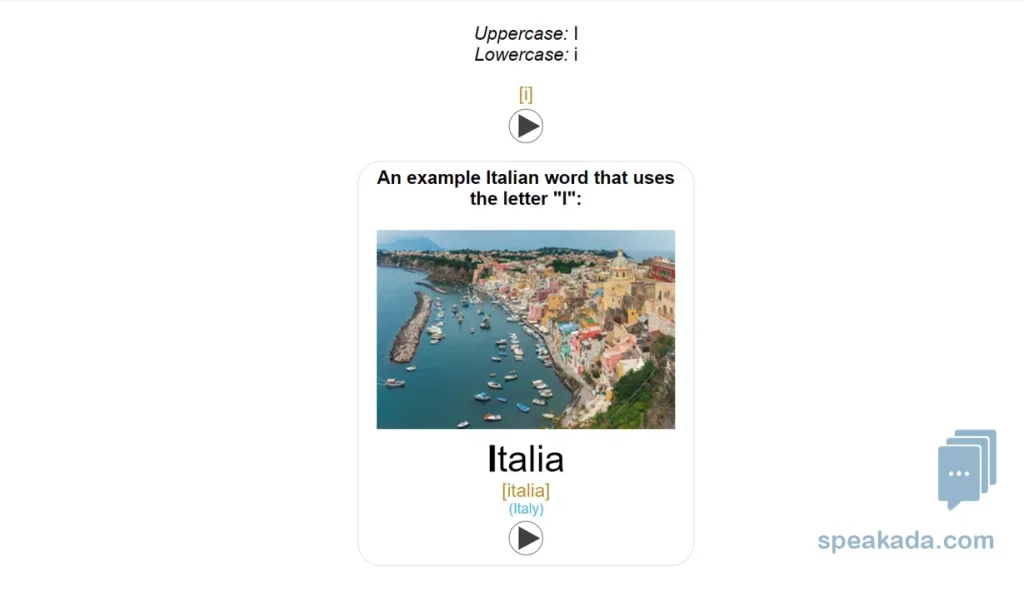
2) IPA Flashcards
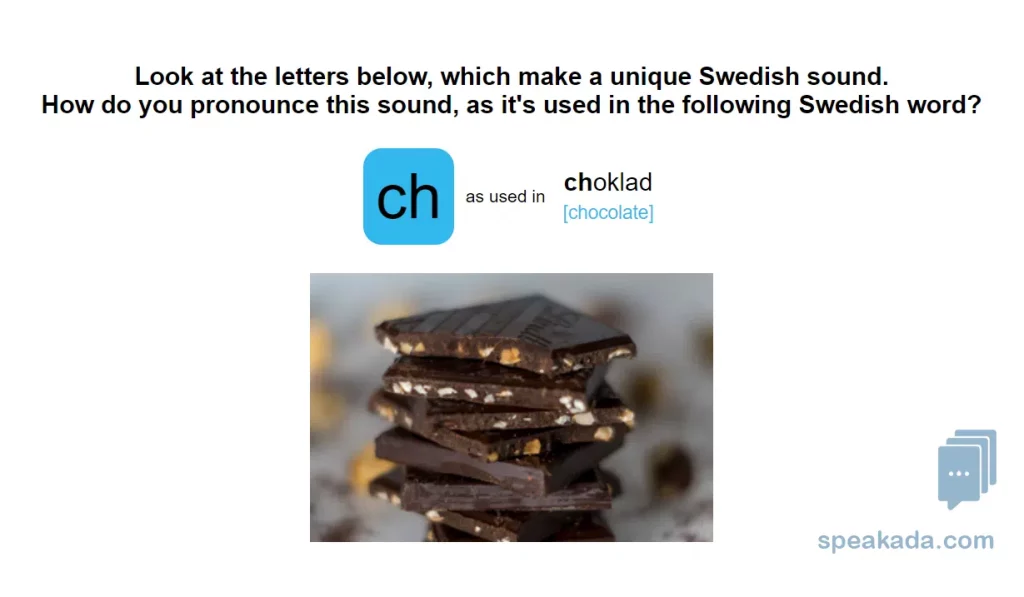
3) Minimal Pairs Flashcards
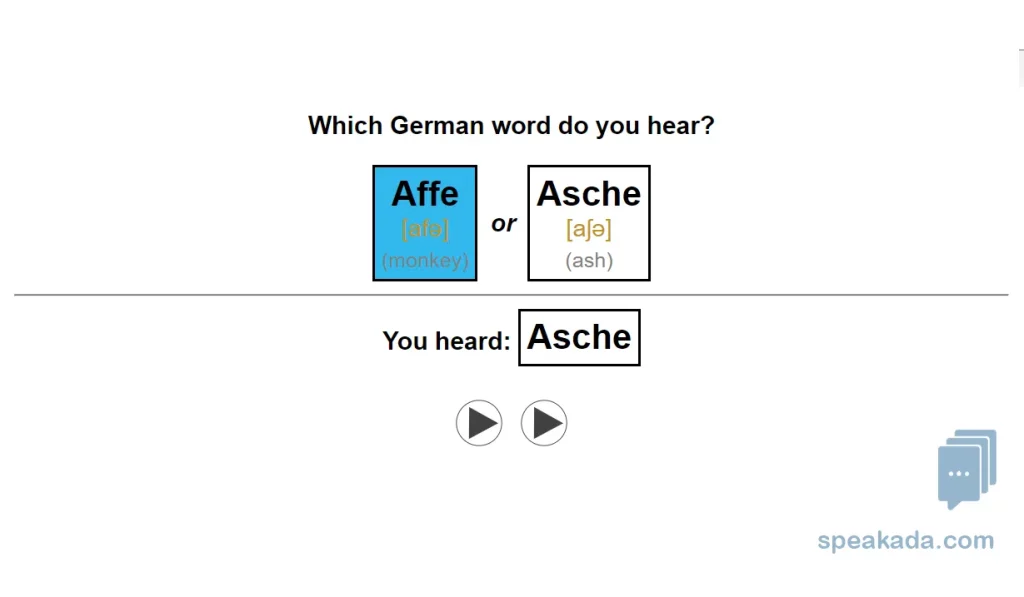
1) Alphabet Flashcards
The alphabet forms the building blocks of language and literacy, and mastering it is crucial for reading, writing, and effective communication. That’s where alphabet pronunciation flashcards come into play.
Alphabet flashcards are a versatile and engaging educational resource designed to introduce and reinforce the letters of the alphabet for beginners.
Visual Learning
Alphabet flashcards present each letter in a clear, bold, and visually appealing manner. They often include both uppercase and lowercase forms of the letter, allowing you to recognize and differentiate between the two.
The visual component aids in memory retention and letter recognition.
Audio Learning
Alphabet flashcards can have audio aids too. By including the sound of each letter, these cards enhance your learning experience. Imagine not only seeing but also hearing the distinct sounds of the alphabet.
To make it even more interactive, some flashcards let you click or tap on a letter to hear its pronunciation. This hands-on approach allows you to replay those tricky alphabet sounds, so you really fine-tune your hearing and pronunciation of each letter.
This dual visual and auditory approach ensures you not only see the letters but also connect them with their unique sounds. It’s a simple yet effective way to grasp the pronunciation of each alphabet letter.
Phonemic Awareness
Many alphabet flashcards go beyond just displaying the letters. They often include images of objects or animals that start with the corresponding letter’s sound.
For example, the letter “A” might be accompanied by an image of an apple. This association helps you develop phonemic awareness by connecting the letter with its sound.
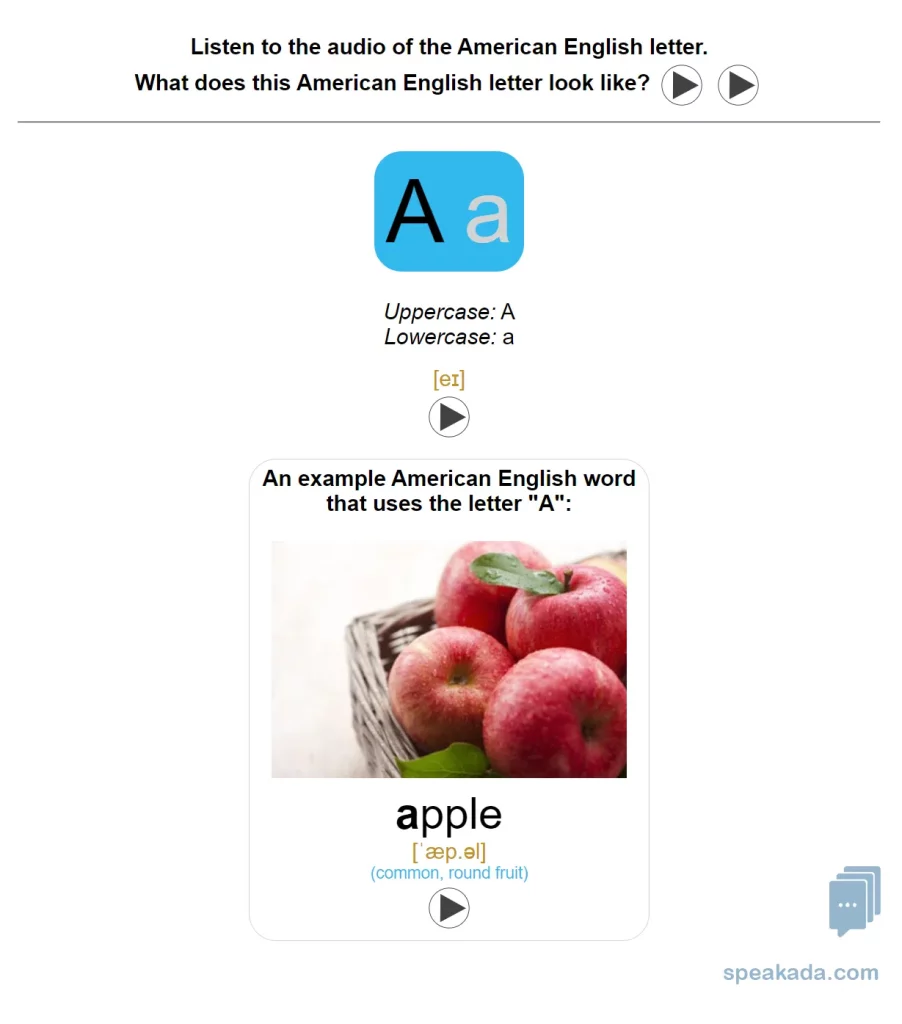
Learn the alphabet with the pronunciation bundle to master pronunciation
2) IPA Flashcards
The IPA, or the International Phonetic Alphabet, is a system of symbols used to represent the sounds of spoken language. For instance, the symbol /θ/ in IPA represents the “th” sound in “think,” and /ð/ represents the “th” sound in “this.”
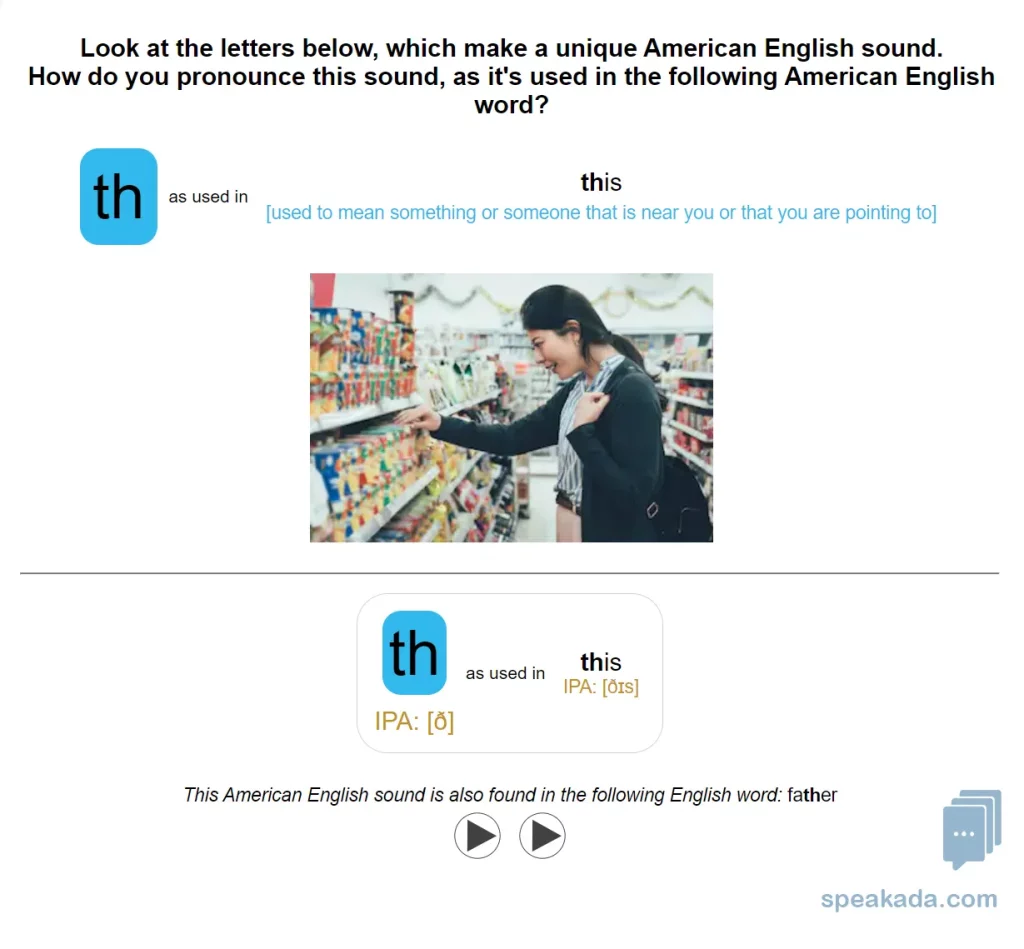
This standardized system is beneficial for linguists, language learners, and teachers, providing a consistent way to transcribe the sounds of all languages.
Navigating Complex Sounds with IPA
To illustrate further, consider the English word “gnat.” In IPA, it is represented as /næt/, breaking down each sound (/n/ for “gn,” /æ/ for “a,” and /t/ for “t”).
Similarly, the Spanish word “jefe” (boss) is represented as /ˈxefe/, capturing the pronunciation of each letter (/x/ for the guttural “j” sound, /e/ for “e,” /f/ for “f,” and /e/ for the final “e”).
The IPA is handy because, in some languages, the way words are spelled doesn’t always match how they’re pronounced. This discrepancy can be confusing, but the IPA steps in to make the correct pronunciation clearer and more straightforward.
Research on the Usefulness of IPA Pronunciation
In a study published in the academic journal “Theory and Practice in Language Studies,” PhD researcher Rajab conducted experiments to highlight the significance of the IPA on pronunciation. The findings showed that students at the tertiary level reached a high understanding of connecting letters to symbols in the IPA system.
The results of oral tests indicated that developing phonological awareness played a crucial role in enhancing students’ writing and speaking skills. Importantly, learning the IPA phonetic transcription codes not only contributed to academic improvement but also empowered students with a greater sense of independence and competence, especially when using monolingual dictionaries.
Leveraging IPA with Flashcards
IPA Flashcards leverage the International Phonetic Alphabet to improve your language skills. They use IPA symbols to represent sounds, allowing you to focus on accurate pronunciation and better understand the intricacies of a language.
By combining the precision of IPA with the practicality of flashcards, IPA Flashcards offer an effective way to enhance your language learning experience.
Key Components of IPA Flashcards
IPA flashcards typically feature the following elements:
1. IPA Symbols as Sound Representation:
Each flashcard features International Phonetic Alphabet (IPA) symbols as visual representations of specific sounds. For example, the IPA symbol [ɲ] represents the “ñ” letter sound in Spanish. The learner begins by understanding how each sound is represented visually.
2. Audio:
Many IPA flashcards include audio recordings of the sounds, so learners can hear the correct pronunciation. This auditory component is crucial for improving pronunciation skills.
3. Example Words:
Each IPA flashcard includes example words or phrases that contain the sound represented by the IPA symbol. This helps learners associate the symbol with real-word pronunciation.
4. Descriptions of the Sound:
Some IPA flashcards may include descriptions of the sound, explaining how it is produced and any unique characteristics. Take, for instance, the “ñ” letter sound in Spanish, represented by the [ɲ] IPA symbol. The IPA flashcard can highlight that this sound can be likened to the “ny” sound in the English word “canyon.”
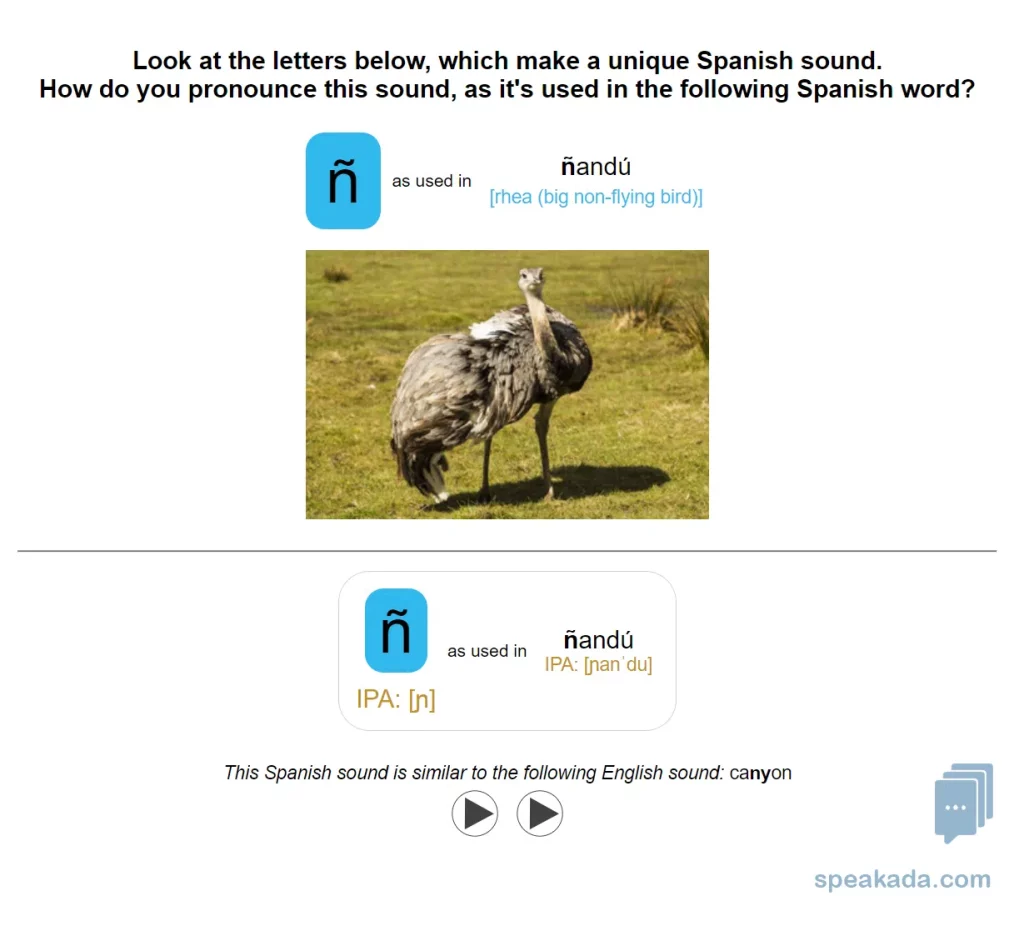
Learn the IPA with the pronunciation bundle to master pronunciation
3) Minimal Pairs Flashcards
Minimal pairs are pairs of words in a language that differ by only one sound, usually a single consonant or vowel. They serve as a way to highlight the significance of individual sounds in the language.
Examples of Minimal Pairs
For example, in English, “bad” and “pad” form a minimal pair because they only differ in the initial sound, /p/ and /b/.
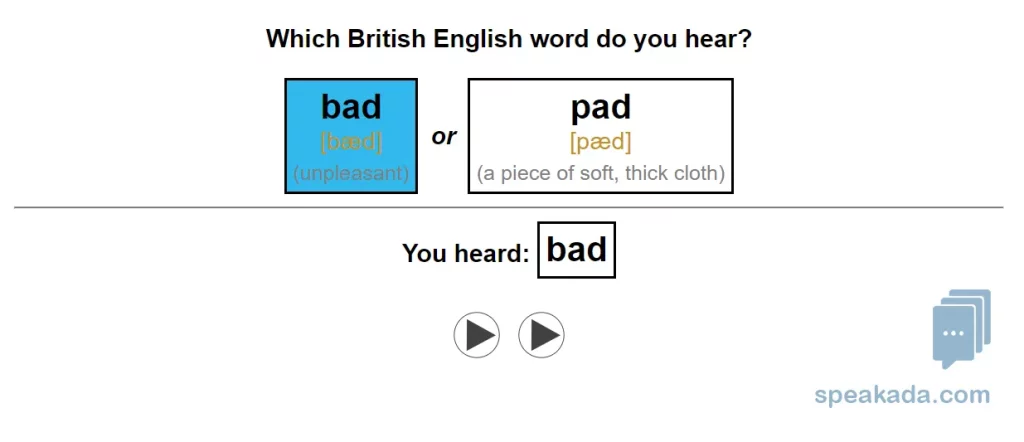
Another example in French is “fou” (crazy) and “fouille” (search). They form a minimal pair because they only differ in the final sound, as shown in their IPA /fu/ and /fuj/ respectively.
These examples illustrate how closely related sounds can impact meaning.
Applying Minimal Pairs in Language Learning
Working with minimal pairs helps learners differentiate between similar sounds and correct common pronunciation errors.
The learner practices distinguishing between two similar sounds, which hones their ability to identify subtle differences. This targeted approach ensures that learners tackle their specific challenges effectively.
Gerald Kelly, a pronunciation expert from Northumbria University (UK) and the author of “How to Teach Pronunciation,” also recommends that language learners effectively use minimal pairs. This approach allows students to concentrate on sounds that might be challenging for them.

6 Ways Minimal Pairs Flashcards Can Help Your Pronunciation
Minimal pairs flashcards offer a focused approach to refining your pronunciation. Here are their main benefits:
- Sound Discrimination: Minimal pairs flashcards are designed to help learners discriminate between similar sounds in the language. By practicing with these flashcards, learners become attuned to the subtle distinctions in pronunciation.
- Phonetic Awareness: They enhance phonetic awareness, which is crucial for grasping the intricacies of a language’s sound system. Learners learn to differentiate between sounds that might otherwise be indistinguishable to them.
- Targeted Practice: Minimal pairs flashcards offer focused practice on specific sounds or sound combinations that are challenging for learners. This targeted approach allows learners to tackle their weaknesses head-on.
- Overcoming Common Mistakes: Many language learners tend to make common pronunciation errors, such as mixing up similar sounds. Minimal pairs flashcards are tailored to address these common pitfalls, enabling learners to correct their mistakes.
- Listening Skills: Working with minimal pairs flashcards sharpens your listening skills. As you practice, you not only learn to produce sounds correctly but also become better at recognizing them when spoken by others, including native speakers.
- Accent Reduction: For learners seeking to reduce their accent in the target language, minimal pairs flashcards are invaluable. They help learners identify the sound differences between their native language and the target language and make the necessary adjustments.
Learn the minimal pairs with the pronunciation bundle to master pronunciation
How Do Pronunciation Flashcards Work?
Pronunciation flashcards serve as valuable aids for language learners aiming to enhance their pronunciation skills. These cards leverage visual, auditory, and contextual elements to help learners understand the nuances of pronunciation more effectively.
These flashcards enable learners to concentrate on specific pronunciation challenges or troublesome sounds, providing targeted and efficient assistance in improving pronunciation.
For optimal results, pronunciation flashcards are most effectively used with Anki, a free flashcards program.
Anki pronunciation flashcards are a potent resource that incorporates spaced repetition and active recall principles, contributing significantly to the enhancement of learners’ pronunciation skills.
Research Backing Anki’s Effectiveness in Language Learning
A study conducted by researchers from Arcadia University, detailed in the academic journal “Computer Assisted Language Learning,” examined the effectiveness of Anki for language learning. The study involved students enrolled in a beginning Spanish course who were required to use Anki for studying.
“The results showed a positive relationship between days studying with Anki and Spanish performance…”
Aroline E. Seibert Hanson & Christina M. Brown (2019): Enhancing L2 learning through a mobile assisted spaced-repetition tool: an effective but bitter pill?, Computer Assisted Language Learning
The findings revealed a positive correlation between the number of days spent studying with Anki and the students’ Spanish performance at the end of the semester. This positive relationship persisted even when considering baseline abilities, motivation, self-efficacy, and beliefs.
3 Steps of Spaced Repetition With Anki Pronunciation Flashcards
Anki uses a spaced repetition algorithm to determine when and how frequently each pronunciation flashcard should be reviewed. This algorithm is designed to optimize memory retention and learning efficiency.
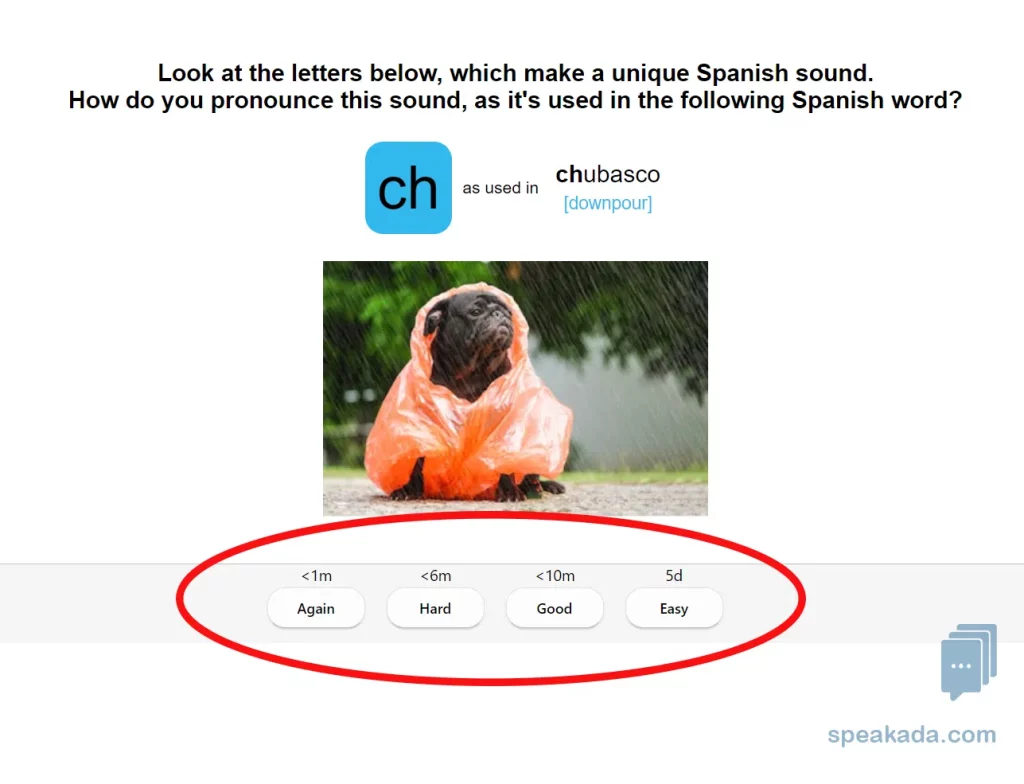
There are 3 steps for how Anki’s spaced repetition system (SRS) works with pronunciation flashcards:
- When a learner reviews a flashcard, they indicate how well they remembered the pronunciation.
- Anki then schedules the next review based on the user’s response. If the learner recalls the pronunciation accurately, the flashcard’s interval increases, leading to less frequent reviews. If the learner struggles, the interval shortens for more frequent reviews.
- Anki continues to present pronunciation flashcards to learners in a carefully spaced manner. The intervals between reviews gradually increase as learners demonstrate proficiency.
The iterative nature of Anki’s spaced repetition system ensures that learners revisit challenging pronunciation until it becomes second nature. This means that Anki personalizes the learning for you because it focuses on pronunciation features that are particularly difficult for you. Learners can use this data to identify areas where they need more practice.
3 Steps of Active Recall With Anki Pronunciation Flashcards
Anki emphasizes active recall, a cognitive process where learners actively try to remember information rather than passively reviewing it.
When reviewing pronunciation flashcards, learners can do these 3 steps:
- Listen to the audio component and try to recall the correct pronunciation before seeing it. This allows learners to hear the correct pronunciation and compare it with their own, honing their listening skills. Hearing the sounds helps learners develop their listening skills and mimic correct pronunciation. The learner listens to the native speaker’s pronunciation to understand the correct way to produce the sound.
- Speak the word or phrase aloud to practice articulating the sounds accurately.
- Compare their own pronunciation to the correct one provided on the flashcard.
This process of actively recalling and reproducing the pronunciation helps reinforce memory and build muscle memory for correct articulation.
Overall, Anki pronunciation flashcards combine the principles of spaced repetition and active recall to provide learners with a structured and efficient way to practice and improve their pronunciation.
By actively engaging with the pronunciation flashcards and progressively extending the intervals between reviews, learners can enhance their ability to pronounce words and phrases accurately and confidently.
Final Thoughts: Pronunciation Flashcards as a Practical Way to Improve Pronunciation in Another Language
In summary, pronunciation flashcards are designed to provide learners with a practical approach to mastering pronunciation. They can help you with sound recognition, articulatory awareness, correct pronunciation, and accent reduction. Overall, this tool can help you quickly pronounce words properly in a foreign language.
Digital pronunciation flashcards with Anki are particularly useful because of their portability, convenience and research-backed effectiveness. The 3 main types of pronunciation flashcards that you can learn with Anki include Alphabet flashcards, IPA flashcards and Minimal Pairs flashcards.
Whether you’re a beginner or an advanced learner, these pronunciation flashcards offer valuable guidance and practice for refining your pronunciation skills and to learn how to pronounce words properly.






